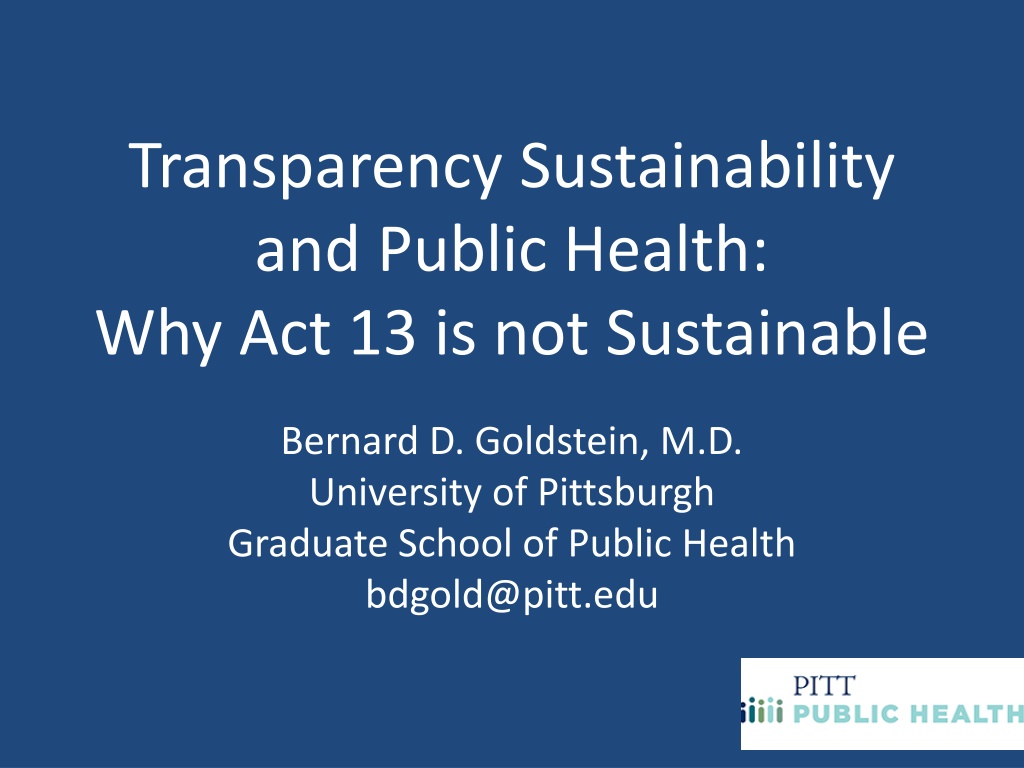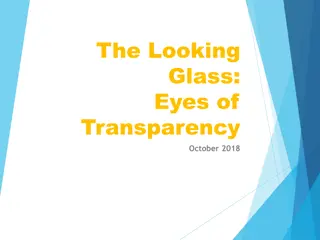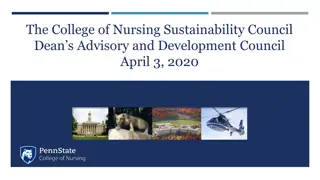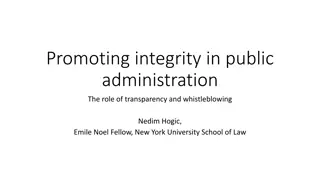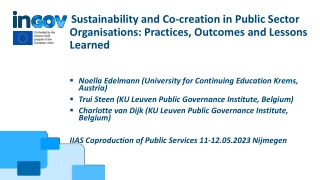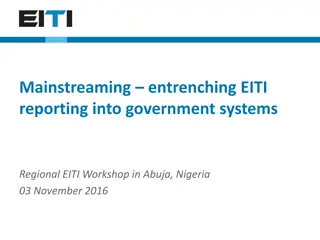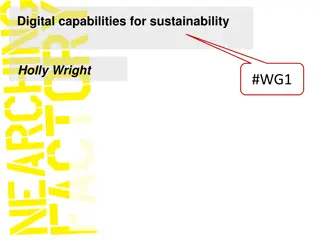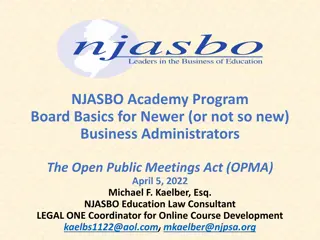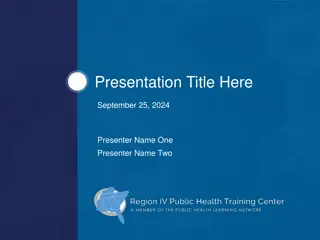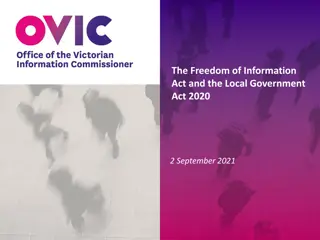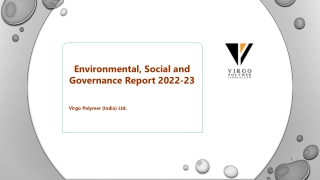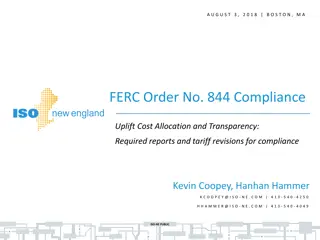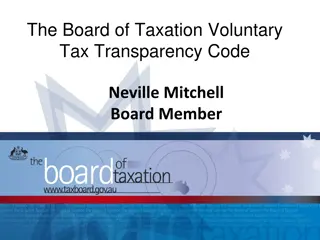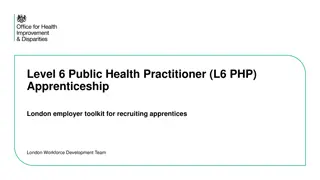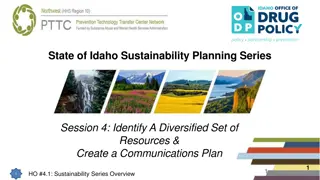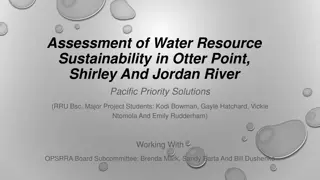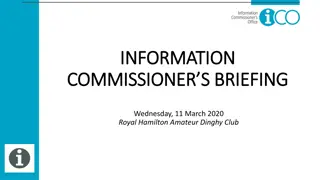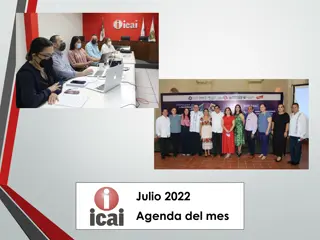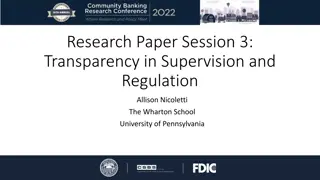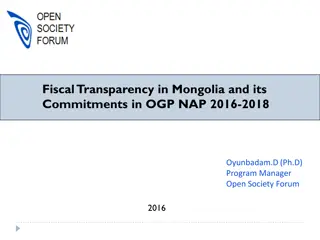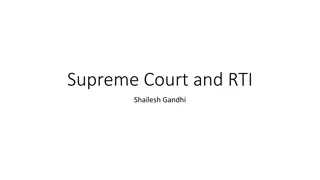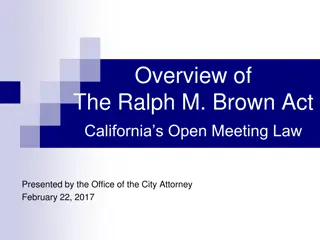Transparency, Sustainability, and Public Health: Why Act 13 is Not Sustainable
This presentation highlights the role of transparency in sustainability, environmental protection, and public health, discussing how governmental policies like Pennsylvania's ACT 13 lack transparency and citizen involvement. It emphasizes the importance of public participation in decision-making for sustainable development, as outlined by various principles and declarations.
Download Presentation

Please find below an Image/Link to download the presentation.
The content on the website is provided AS IS for your information and personal use only. It may not be sold, licensed, or shared on other websites without obtaining consent from the author. Download presentation by click this link. If you encounter any issues during the download, it is possible that the publisher has removed the file from their server.
E N D
Presentation Transcript
Transparency Sustainability and Public Health: Why Act 13 is not Sustainable Bernard D. Goldstein, M.D. University of Pittsburgh Graduate School of Public Health bdgold@pitt.edu
Overview of Presentation Transparency has an important role in sustainability, in environmental protection, and in public health In recent decades, governmental environmental policy in the US and elsewhere has moved toward enhanced citizen involvement and transparency Pennsylvania s ACT 13 represents environmental recidivism in its return to discarded practices that limit citizen s knowledge and input. The lack of transparency and trust amplifies public perception of risk
Role of Public Participation Dernbach, J. C. (2002). "Sustainable Development: Now More Than Ever." Environmental Law Institute 32: 10003-10019. Agenda 21 and the Rio Declaration speak repeatedly of the importance and need for public participation, not only in governmental decisionmaking but also, and more broadly, in the work of sustainable development
Stockholm: Principle 10 Environmental issues are best handled with participation of all concerned citizens, at the relevant level. At the national level, each individual shall have appropriate access to information concerning the environment that is held by public authorities, including information on hazardous materials and activities in their communities, and the opportunity to participate in decision-making processes. States shall facilitate and encourage public awareness and participation by making information widely available. United Nations Environment Programme (1972). Report of the United Nations Conference on the Human Environment. Stockholm. Principle 10 http://www.unep.org/Documents.Multilingual/Default.asp?documentid=78&articleid=1163
United Nations Global Compact Principle 8: Businesses should undertake initiatives to promote greater environmental responsibility. Steps that the company could take to promote environmental responsibility would be the following: Ensure transparency and unbiased dialogue with stakeholders. United Nations. (2009, 12 February 2009). Businesses should undertake initiatives to promote greater environmental responsibility. Global Compact Principle 8. from http://www.unglobalcompact.org/aboutthegc/thetenprinciples/principle8.html
World Business Council for Sustainable Development Governance also enables and guides markets by clarifying limits and establishing frameworks that promote transparency, inclusiveness, internalized externalities, and other characteristics of sustainability. World Business Council for Sustainable Development (2010). Vision 2050. Geneva, Switzerland: 1-21. http://www.wbcsd.org/pages/edocument/edocumentdetails.aspx?id=219&nosearchcontextkey=true
Precautionary Principle Primary Prevention Taking preventive action in the face of uncertainty Shifting the burden of proof to the proponents of an activity Exploring a wide range of alternatives to possibly harmful action Increasing public participation in decision making Nussbaum RH, Hoover PP, Grossman CM, Nussbaum FD. Community-based participatory health survey of Hanford, WA, Downwinders: A model for citizen empowerment. Society and National Resources 17:547-559. 2004.
EPAs Mission Statement all parts of society -- communities, individuals, businesses, and state, local and tribal governments -- have access to accurate information sufficient to effectively participate in managing human health and environmental risks. Environmental Protection Agency. (2013). Our Mission and What We Do. http://www2.epa.gov/aboutepa/our-mission-and-what-we-do
Margaret Hamburg, M.D. Commissioner of the Food and Drug Administration Transparency is a potent element of a successful strategy to enhance the work of the FDA and its credibility with the public. Whenever possible, the FDA should provide the data on which it bases its regulatory decisions and other guidance and explain its decision-making process to the public. Hamburg, M. A. and J. M. Sharfstein (2009). "The FDA as a public health agency." N Engl J Med 360(24): 2493-2495.
Governments Role in Protecting Health and Safety Potential Public Health Actions of a Responsive Government Promoting Free and Open Information Protecting Individuals from Harm Caused by Other People or by Groups Taking Societal Action to Protect and Promote Health Frieden, T. R. (2013). Government's Role in Protecting Health and Safety. New England Journal of Medicine, 368(20), 1857-1859.
Government's Role in Protecting Health and Safety. Free and open information empowers people to make informed choices and reduces the likelihood that misinformation or hidden information will endanger health. Laws may require disclosure of factual information (e.g., product content), provide for government transparency (freedom of information), or prevent dissemination of inaccurate or misleading information. (emphasis added) Frieden, T. R. (2013). Government's Role in Protecting Health and Safety. New England Journal of Medicine, 368(20), 1857-1859. doi: doi:10.1056/NEJMp1303819
White House Open Government Working Group Principles of Open Government Complete Primary Timely Accessible Machine-processable Non-discriminatory Non-proprietary License-free Open Government Working Group. (2007). Open Government Data principles. Retrieved September 24, 2013, from https://public.resource.org/8_principles.html
State Hydraulic Fracturing Disclosure Rules and Enforcement: A Comparison McFeeley, M. (2012). NRDC Issues Brief (Vol. IB: 12-06-A, pp. 1-16) Trade secret exemptions create loopholes in most rules, allowing companies to deem information proprietary and prevent disclosure. In many states, disclosure requirements written into state rules are not consistently enforced And some states provide certain information to the public only via physical inspection of well records, severely limiting its availability.
The Pennsylvania gas law fails to protect public health Our legislators punted when it was time to protect us, BERNARD D. GOLDSTEIN and JILL KRIESKY Pittsburgh Post-Gazette March 11, 2012 Response by Patrick Henderson, Energy Executive to PA Governor Corbett This is the most progressive hydraulic fracturing disclosure law in the nation. It builds upon a national model adopted in Colorado -- a law which was universally praised, even by groups as environmentally demanding as the Environmental Defense Fund. The law protects proprietary information from disclosure to the general public, but not from environmental or health officials. Henderson, P. (March 14, 2012). Gas Law Protects Pennsylvanians. Pittsburgh Post- Gazette. Environmental Defense Fund People have a right to know what chemicals are being used in their community, what is being emitted into the air, and what is in the wastewater being produced on site Environmental Defense Fund (2013). "Natural gas: Five areas of concern." from http://www.edf.org/climate/five-areas-of- concern
Shouldnt We be Thankful that ACT 13 Requires Disclosure of Site-Specific Hydrofracturing Chemicals? Consider a physician responding to a family concerned about whether a child s symptoms could be due to living near a drill site. Before ACT 13: MD would consult a list of hundreds of chemical and would certainly find one that could cause the symptoms After ACT 13: MD would consult a list of perhaps 8 chemicals and is likely not to find a possible causal link IT IS IN INDUSTRY S BEST INTEREST TO PROVIDE A SITE-SPECIFIC LIST OF HYDROFRACTURING CHEMICALS
Occupational Safety and Health Act Access to employee exposure and chemical records 1910.1020 (f)(2) The employer may withhold the specific chemical identity, including the name and other specific identification of a toxic substance from a disclosable record provided that: 1910.1020 (f)(2)(i) The claim that the information withheld is a trade secret can be supported; 1910.1020 (f)(2)(ii) All other available information on the properties and the effects of the toxic substance is disclosed. 1910.1020 (f)(2)(iv) The specific chemical identity is made available to health professionals, employees and designated representatives in accordance with the specific applicable provisions of this paragraph. Occupational Safety & Health Administration. Access to employee exposure and medical records. osha.gov: Retrieved from https://www.osha.gov/pls/oshaweb/owadisp.show_document?p_table=STANDARDS&p_id=10 027.
Act 13 House Bill 1950 (10) A vendor, service company or operator shall identify the specific identity and amount of any chemicals claimed to be a trade secret or confidential proprietary information to any health professional who requests the information in writing if the health professional executes a confidentiality agreement and provides a written statement of need for the information indicating all of the following: i. The information is needed for the purpose of diagnosis or treatment of an individual. ii. The individual being diagnosed or treated may have been exposed to a hazardous chemical. iii. Knowledge of information will assist in the diagnosis or treatment of an individual.
What his/her lawyer should tell a health professional about CBI Once you sign the document allowing you to obtain confidential business information (CBI): If you release the information you are legally liable for any business loss sustained by the company. (Halliburton values their hydrofracturing secrets at upwards of $200 million) It is highly unlikely that any such law suit will be covered by your malpractice insurance. So you would need to hire your own lawyers. If you think the CBI chemical could be causing health problems, PA state law requires you to divulge this secret information to public health authorities. It is not clear whether you are legally liable if the public health authorities then release the secret information It would take an exceptionally brave (or foolhardy) health professional to request CBI
Environmental Recidivism: Disclosures Not Required Under PA Act 13 Notwithstanding any other provision of this chapter, a vendor, service provider or operator shall not be required to do any of the following: (1) Disclose chemicals that are not disclosed to it by the manufacturer, vendor or service provider. (2) Disclose chemicals that were not intentionally added to the stimulation fluid. (3) Disclose chemicals that occur incidentally or are otherwise unintentionally present in trace amounts, may be the incidental result of a chemical reaction or chemical process or may be constituents of naturally occurring materials that become part of a stimulation fluid. Emphases added
Language of the Executive Orders Creating Unconventional Natural Gas Drilling Advisory Committees task the Secretary of Energy Advisory Board (SEAB) with establishing a subcommittee to develop, within six months, consensus recommended advice to the agencies on practices for shale extraction to ensure the protection of public health and the environment (emphasis added) -President Barak Obama in Blueprint for a Secure Energy Future (March 2011) The Marcellus Shale Safe Drilling Initiative will assist State policymakers and regulators in determining how gas production from the Marcellus shale in Maryland can be accomplished without unacceptable risks of adverse impacts to public health, safety, the environment and natural resources (emphasis added) -Maryland Governor Martin O Malley in Executive Order 01.01.2011.11: The Marcellus Shale Safe Drilling Initiative (June 2011) WHEREAS, the Commonwealth takes seriously its responsibility to ensure the development of natural gas in a manner that protects the environment and safeguards the health and welfare of its citizens (emphasis added) -Pennsylvania Governor Tom Corbett in Executive Order 2011-011: Creation of Governor s Marcellus Shale Advisory Commission (March 2011)
Agencies, Sub-Agencies, and Commissions specified to receive funding from PA impact fee (BUT NOT THE DEPARTMENT OF HEALTH) 1. 2. 3. 4. 5. 6. 7. 8. 9. 10. 11. 12. 13. 14. 15. 16. 17. County Conservation Districts State Conservation Commission Pennsylvania Fish and Boat Commission Public Utility Commission Department of Environmental Protection of the Commonwealth Pennsylvania Emergency Management Agency Office of State Fire Commissioner Department of Transportation Natural Gas Energy Development Program (DEP) Counties and municipalities Housing Affordability and Rehabilitation Enhancement Fund Commonwealth Financing Authority Environmental Stewardship Fund Motor License Fund (DOT) Pennsylvania Infrastructure Investment Authority Department of Community and Economic Development Hazardous Sites Cleanup Fund
Risk Amplification personal experience of a natural hazard and trust or lack of trust in authorities and experts have the most substantial impact on risk perception. Cultural and individual factors such as age, gender, education, income, social status, and others do not play such an important role but act as mediators or amplifiers of the main causal connections between experience, trust, perception, and preparedness to take protective actions. Wachinger, G., et al. (2013). "The Risk Perception Paradox Implications for Governance and Communication of Natural Hazards." Risk Analysis 33(6): 1049- 1065.
